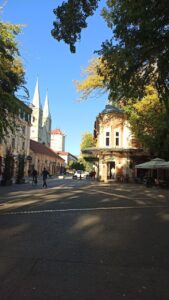How real estate shapes Subotica’s cultural landscape
Subotica, a city located in northern Serbia, is a vibrant tapestry of cultural influences, historical narratives, and architectural diversity. The interplay between real estate development and cultural identity in Subotica is profound, as the built environment not only reflects the city’s historical context but also shapes its contemporary cultural landscape. This article explores how real estate influences Subotica’s cultural identity, the preservation of its architectural heritage, and the socio-economic dynamics that emerge from urban development.
The Influence of Real Estate on Cultural Identity
Real estate in Subotica serves as a physical manifestation of the city’s cultural identity, which is a blend of various ethnicities, traditions, and historical epochs. The architectural styles found throughout the city, from Art Nouveau buildings to modernist structures, tell a story of the diverse influences that have shaped Subotica over the years. Each building, whether it be a residential home or a public institution, contributes to the overall narrative of the city, reflecting the aspirations and lifestyles of its inhabitants.
Moreover, the real estate market in Subotica has been influenced by migration patterns and demographic changes. As different communities have settled in the area, they have brought with them distinct cultural practices and architectural preferences. This has led to a rich mosaic of styles and forms that not only define the city’s skyline but also foster a sense of belonging among its residents. The ongoing development and renovation of properties often aim to honor this diversity, ensuring that new constructions resonate with the historical context of the area.
However, the rapid pace of real estate development poses challenges to Subotica’s cultural identity. Gentrification and the commercialization of certain neighborhoods can lead to the erosion of local traditions and the displacement of long-standing communities. As developers prioritize profit over cultural preservation, the risk of losing the unique character that defines Subotica becomes increasingly pronounced. Thus, the relationship between real estate and cultural identity is complex, requiring careful consideration and balance.
Preservation of Architectural Heritage
Subotica is renowned for its architectural heritage, particularly its Art Nouveau buildings, which are among the finest examples of this style in Europe. The preservation of these structures is crucial not only for maintaining the aesthetic appeal of the city but also for safeguarding its cultural history. Real estate development plays a pivotal role in this preservation effort, as developers and local authorities must navigate the delicate balance between modernization and heritage conservation.
The city has implemented various regulations and initiatives aimed at protecting its architectural landmarks. These measures often include restrictions on alterations to historical buildings and incentives for developers to restore rather than demolish. By promoting adaptive reuse of existing structures, Subotica can maintain its historical character while accommodating contemporary needs. This approach not only preserves the city’s cultural landscape but also enhances its attractiveness as a destination for tourism and investment.
Community engagement is also essential in the preservation of Subotica’s architectural heritage. Local residents, historians, and cultural organizations often advocate for the protection of significant sites, emphasizing the importance of these buildings in the collective memory of the city. Through public awareness campaigns and collaborative efforts with real estate developers, the community can play an active role in shaping the future of Subotica’s urban landscape, ensuring that development aligns with cultural preservation goals.
Socio-Economic Dynamics of Urban Development
The socio-economic implications of real estate development in Subotica are multifaceted, influencing not only the physical landscape but also the social fabric of the city. As new residential and commercial properties emerge, they can stimulate economic growth by attracting businesses and creating job opportunities. This influx of investment can lead to improved infrastructure and services, enhancing the overall quality of life for residents.
However, the benefits of urban development are not evenly distributed. Disparities in access to housing and resources can exacerbate social inequalities, particularly for marginalized communities. The rising cost of living associated with gentrification can push long-time residents out of their neighborhoods, leading to a loss of cultural diversity and community cohesion. As such, it is crucial for policymakers and developers to adopt inclusive practices that prioritize affordable housing and equitable access to resources.
Furthermore, the cultural landscape of Subotica is shaped by the interactions between different socio-economic groups. The blending of cultures, ideas, and traditions can lead to a dynamic urban environment that fosters creativity and innovation. By embracing diversity and promoting social inclusion, Subotica can leverage its real estate development to enhance its cultural richness, ensuring that the city remains a vibrant and welcoming place for all its residents.
In conclusion, real estate plays a significant role in shaping Subotica’s cultural landscape, influencing its identity, architectural heritage, and socio-economic dynamics. The interplay between development and preservation is critical in maintaining the city’s unique character while accommodating growth and modernization. As Subotica navigates the challenges and opportunities presented by real estate, it is essential to prioritize cultural preservation and social equity to ensure a vibrant and inclusive future for all its inhabitants. The careful stewardship of its built environment will ultimately define Subotica’s cultural legacy for generations to come.


